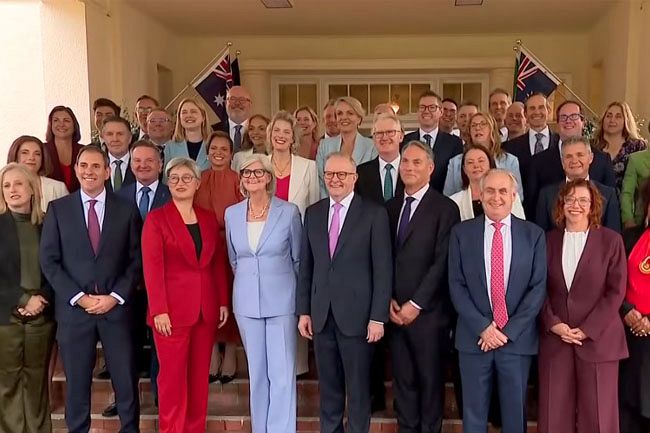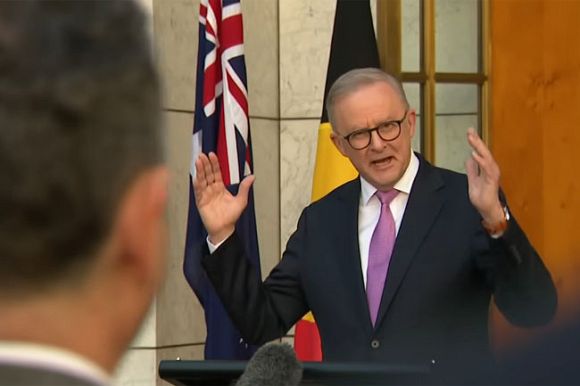Media treatments of the aftermath of the 3 May elections spent so much time on Opposition parties, replacing leaders who lost their seats and factional squabbles, that there was little focus on where the continuing, secured Labor Government would now be taking the country.
Dr Lee Duffield writes that, barring collapse in the outside world, it has the makings of great change for Australian society.
Classic and traditional shape of a Labor government
Since Prime Minister Anthony Albanese and Treasurer Jim Chalmers got news of the interest rate reduction on 18 February, they exuded confidence in setting out a set-piece program.
It signalled a classic and characteristic Labor Party government project, to get general prosperity and provide opportunities, with emphasis on breaks for lower-income earners. That had to be calibrated against demands of the times, from the overbearing threat of climate change to precarious global security.
Future plan for Australia
Main outlines of the plan, boiled down from announcements in the election campaign:
- Relief measures to reduce the cost of living without aggravating inflation (such as electricity rebates) had defused public anger directed at the Government, though anxiety would continue.
- An aggressive house-building program was underway (after a delay by non-government senators, including Greens, and slowed by supply problems and workforce shortages).
- Extensive restoration work on Medicare, moving to universal bulk billing.
- Building on foundational work on new industries would be foregrounded, promoting the exploitation of rare minerals
- Getting up real wages, through such moves as applications to the Fair Work Commission for expanded payments at the lower end, and also the mandated wage rises, coupled with reform in the aged care and early childhood areas. Industrial reforms on conditions and rights can be expected, like the “right to disconnect”, leaving a job to go to another employer. Unions and Labor working together.
- On environment: There is the transition to renewable energy project, which has been getting practical public support with, for example, one-third of households using rooftop solar panels to date. It is a desperate response to climate change and the oncoming linked demand for abundant power for vehicles and advanced computing. Determining a workable carbon emissions goal for 2030 will be a key goal; also setting up the promised Environmental Protection Agency to try and keep production sustainable.
- Defence of the country has been pegged on diplomatic work to keep multilateralism: peaceful free trade in a rules-based world order. Against the threat of world anarchy and war, there is revised and expanded defence spending focused on new forms of weaponry; and against any grim apocalyptic future, throwing in with a United States defence of the Pacific with nuclear submarines.
The sum of all this, which certainly amounts to democratic “big government”, is, as the present Prime Minister has declared, a reprise of the Gough Whitlam dictum for any Labor government: Australia is good and needs to be better.
Activity on the other side
Funding such reforms out of economic growth must be an anathema to the conservative Opposition: no scope for billionaire tax handouts, no tightening of services under “small government”, no outsourcing of government responsibilities to pay-through-the-nose privateers.
The three years of the first Albanese Government saw plenty of opposition to the developing Labor model. The idea of a party drawing support mostly from workers and made up of employees more than any other sector, to this time, puts off a lot of the self-perceived middle class. We had the spectacle of Labor surrounded by carping bourgeois parties of different kinds, even including the mercurial Greens, who attacked Albanese for three years, danced and flirted with the “No” vote against Indigenous Australians, then hopped onto the wave of animosity towards the Opposition Leader, to spend the last three weeks campaigning to “get rid of Peter Dutton”.
The main right-wing party, the Liberals, are split between two main alternatives: (a) in line with tradition, holding out to provide an entitled stewardship of the economy, favourable to business, with a genuine commitment to legal rights and (b) going over to MAGA style reactionary politics on the extreme Right. Most of the partner party, the Nationals, are already over there, waiting.
The aforementioned Dutton turned out to have no policies developed in time for the 2025 elections. Possibly, it revealed an actual lack of ideas, knowledge or talent in his party, or what Labor Treasurer Jim Chalmers is calling ‘intellectual horsepower’. Dutton was certainly tempted to try and stir up some MAGA-Trump feeling against migrants, public servants, who would be sacked, and employees working from home, but all that came up against the fact that the rash policies of U.S. President Donald Trump had made him greatly unpopular in Australia. Forced to back off, chop and change, the leader billed as a strong man started to get ridiculed.
Rumbling in the radical Right
Yet the radical brigade will not give up. Various gangs, clubs and friendship groups will be gathering on the extreme Right, hoping to have yet another go, the idea being to get a turnaround in voter support on the back of anger and rejection, or fear of change. Circumstances might help it, like a world recession. It would be aimed at keeping out migrants, repressing Black youth, managing concerns over climate change by denying it is happening, suspending rights so as to handle an “emergency” and the like. The MAGA-Trump parallels are plain to see; it is not plain to see how far such movements might yet be able to travel in Australia.
A third strand of Liberal policy-making, neoliberalism, appears to have been dumped or indefinitely shelved. Nobody really believed the ridiculous nostrums of its father, Milton Friedman, that the economy could be managed just by controlling the money supply, with no other controls or constraints on capitalist activity. It was essentially a cover for go-for-broke, greed-is-good over-production that proved ruinous for the environment, not to mention many human lives.
Everybody has now woken up to it, but the mess remains — like the obscene disparities in wealth.
Amongst Dr Lee Duffield’s vast journalistic experience, he has served as ABC's European correspondent. He is also an esteemed academic and member of the editorial advisory board of Pacific Journalism Review and elected member of the University of Queensland Senate.
 This work is licensed under a Creative Commons Attribution-NonCommercial-NoDerivs 3.0 Australia License
This work is licensed under a Creative Commons Attribution-NonCommercial-NoDerivs 3.0 Australia License
Support independent journalism Subscribe to IA.

Related Articles
- Now let’s see how Labor transforms the nation
- Labor victory proves public rejected malicious media falsehoods
- Labor turns nature summit into blatant act of hypocrisy
- Labor sitting pretty to win 2025 Election
- Labor continues double-speak on forestry issues














